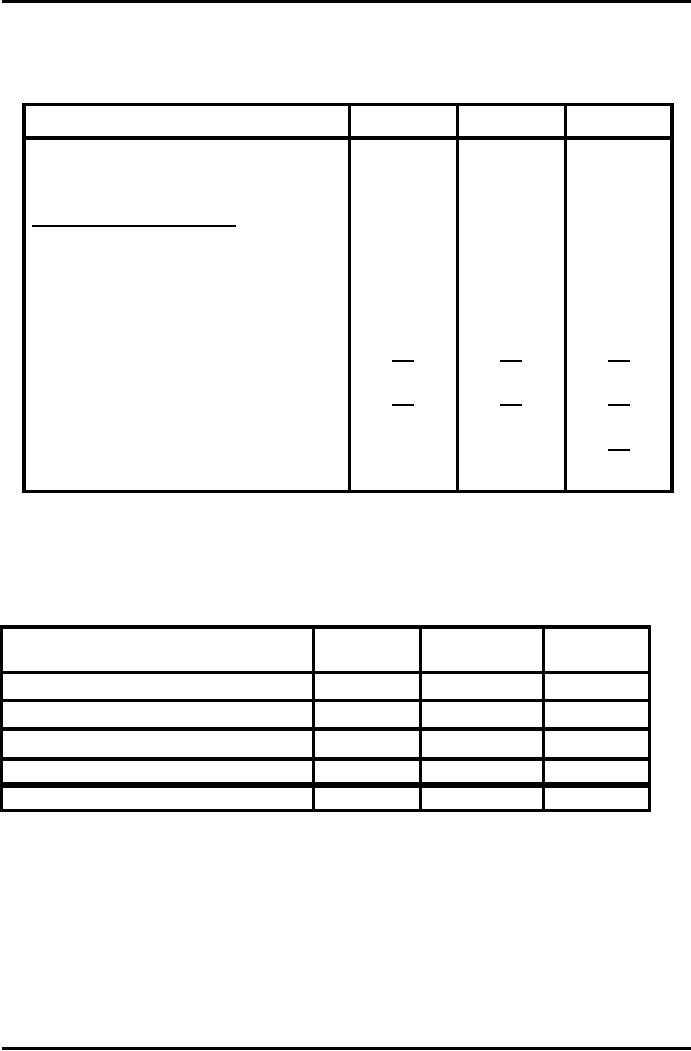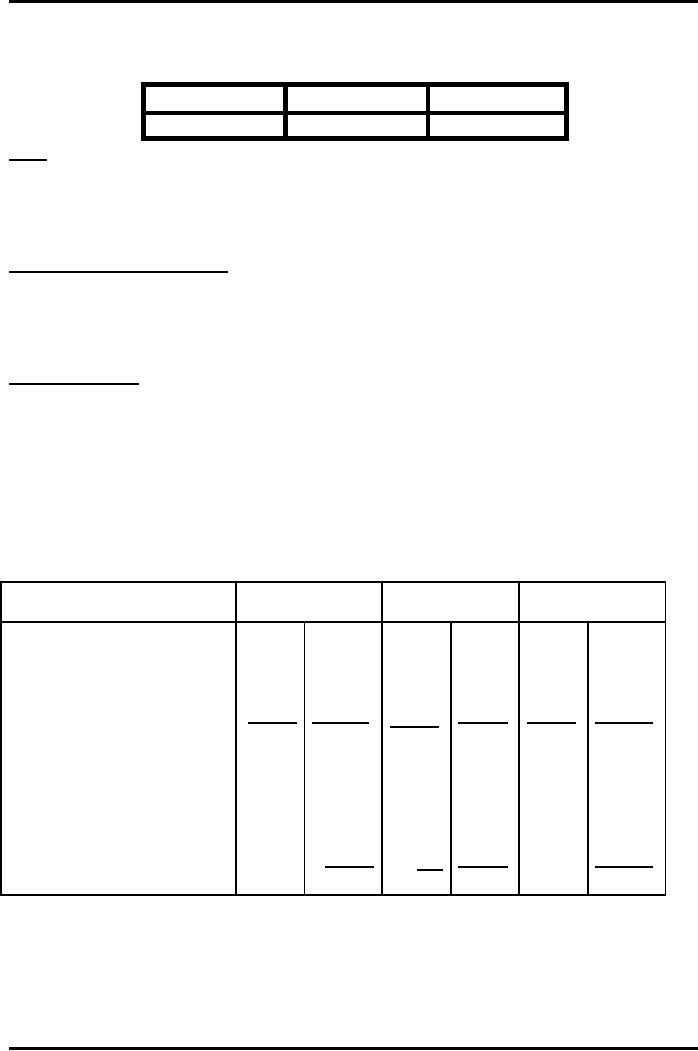 |
DEPARTMENTAL ACCOUNTS 1 |
| << PREPARATION OF FINANCIAL STATEMENTS OF NON-PROFIT ORGANIZATIONS FROM INCOMPLETE RECORDS |
| DEPARTMENTAL ACCOUNTS 2 >> |

Advance
Financial Accounting
(FIN-611)
VU
LESSON
# 9
DEPARTMENTAL
ACCOUNT
A
business entity where
diversified natures of economic
activities are undertaken
is
split
into number of departments for accounting
purposes. Generally it is
management
who will
decide the number of departments in which
the whole business is to be
divided,
but the criteria for identifying
the departments in an examination
question is
always
the separate sales/work-done
revenue.
Each
department is considered as a profit
centre, though none of the
departments is
separated
geographically from the rest of
the departments. This type of
organizational
subdivision
creates a need for internal
information about the
operating results
(profitability)
of each department. Based upon
the departmental knowledge
of
profitability
and growth rate the management
takes certain decisions e.g.
pricing,
costing,
sales promotion, closure
etc.
Allocation
of Incomes and Expenses
Until
unless the size of the
business entity is very large,
the entire book
keeping
system
for the entity is kept by a
central accounts department
along with some
departmental
specific records e.g. sales,
purchases, stocks and staff
salaries etc. Rest of
the
operating expenses and other
incomes need to be allocated
among the
departments
based on their nature, utility,
economic benefits and
belongingness.
For
allocation and division purposes
the expenses/incomes can be
categorized as:
1.
Separately identified
2.
Obvious just ratio
3.
Specific ratio/sales
ratio
4.
Un-allocable
Separately
identified
It
depends upon the size of the
entity that it can
separately identify its
expenses with
each
of the department, a large
entity will be incurring most of
the operating
expenses
that
are department specific e.g.
carriage inward, receiving and
handling, wages and
salaries,
electricity, telephone, repair and
maintenance, entertainment,
advertisement,
sales
promotion, selling commissions,
research and development cost
etc.
Obvious
just ratio
Most of
the expenses are allocated
on the most logical basis
that is obvious and
also
just.
Nature of the expenses and
nature of the business will
determine the basis
for
division.
Some important basis and
expenses are given
below:
S#
Basis
Expenses
1
Sales/Work-done
Revenue
Selling
and distribution expenses
After
sales service
Discount
allowed
Carriage/freight
outward
Bad
debts
Selling
commissions
Advertisement
2
Number of
Employees
Salaries
and wages
Staff
welfare
43

Advance
Financial Accounting
(FIN-611)
VU
Canteen/cafeteria
facility
Group
insurance
3
Area
Occupied
Building
rent
Building
depreciation
Building
insurance
Building
repair and maintenance
Air
conditioning and heating
Property
tax
Inter-com
4
Purchases
of
goods/raw
Carriage/freight inward
material
Import
duties
Custom
tax
Receiving
and handling cost
Discount
received (income)
Specific
ratio or sales ratio
Still
there are some expenses
which provide economic benefits to
more than one
department
and should be allocated but the
ratio is not obvious, for such
expenses a
specific
ratio will be determined or otherwise
these will be divided in the
ratio of their
respective
departmental sales revenue.
These may include:
Insurance
on stock/inventory
Insurance
on plant and machinery
Power
and fuel
Depreciation/Amortization
Un-allocable
These
are the expenses which
provide economic benefits to
the business entity on
the
whole;
these cannot be identified with a
specific department. Such
expenses are often
incurred
against financial facilities.
Examples include; loss on
disposal of investments,
damages
paid for infringement of law, interest on
loan and bank overdrafts
etc.
There
are certain financial
incomes as well that cannot be
identified or allocated
among
the department e.g. interest
on investment, profit on disposal on
investments,
profit
on fixed deposits
etc.
All
these types of expenses and
incomes are shown in a general
profit and loss
account
where
profits or losses of each
department are clubbed to
ascertain the
operating
results
of the business on the
whole.
Allocation
of income tax
expense
Unlike
other operating expenses
income tax expense is
divided on the basis
of
departmental
operating profits. Some
students having knowledge of
income tax law
may
possibly get confused that
nevertheless there are
certain expenses or
losses
admissible
from the tax stand point
that are shown in the
general profit and
loss
account
have not yet been deducted from
the departmental operating
results then why
this
income tax expense is being
charged before subtracting
certain expenses.
Remember
this is just an allocation of
income tax expense (that
has already been
calculated)
among the different
departments. It has nothing to do with
the calculation
of
taxable profit or income tax
charge for the year.
44

Advance
Financial Accounting
(FIN-611)
VU
Format
of departmental profit and loss
account
Income
statement
For
the year ended December
31, 2008
Particulars
A
B
Total
***
Sales
***
***
***
Less
Cost of goods sold
***
***
***
Gross
profit
***
***
Less
Operating expenses
Salaries
& Wages
***
***
***
Rent,
rates & taxes
***
***
***
Repair
& renewal
***
***
***
Lighting
& heating
***
***
***
Profit
from operations
***
***
***
Add
Other incomes
***
***
***
Profit
before tax
***
***
***
Less
Income tax
***
***
***
Net
profit/Profit after
tax
***
***
***
Less
General expenses
-
-
***
Net
profit of the
business
***
Solved
Problem:
From
the following information of Trendy Store
prepare departmental
Income
Statement
and also compute net profit
of the entity on the whole for
the year ending
on
31.12 2008
Particulars
Jewellery
Hairdressing
Clothing
Rs.
Rs.
Rs.
Opening
stock (1/1/2008)
2,000
1,500
3,000
Purchases
11,000
3,000
15,000
Closing
stock (31/12/2008)
3,000
2,500
4,000
Sales and work
done
18,000
9,000
27,000
Staff
salaries
2,800
5,000
6,000
Following
expenses cannot be traced to any
particular department:
Rupees
Rent
3,500
Repair
expenses
4,800
Air
conditioning & lighting
2,000
General
expenses
1,200
Basis
of allocation
Rent
& Air-conditioning expense Floor
space occupied
Repairs
& General expense
Sales
and work done
45

Advance
Financial Accounting
(FIN-611)
VU
Floor
space occupied ratio:
Jewellery
Hairdressing
Clothing
1/5
1/2
3/10
Rent
Jewellery
3,500
x 1/5 =
700
Hairdressing
3,500
x 1/2 =
1,750
Clothing
3,500
x 3/10 =
1,050
Air
conditioning & lighting
Jewellery
2,000
x 1/5 =
400
Hairdressing
2,000
x 1/2 =
1,000
Clothing
2,000
x 3/10 =
600
Repair
expenses
Jewellery
4,800
x 18/54 =
1,600
Hairdressing
4,800
x 18/54 =
800
Clothing
4,800
x 18/54 =
2,400
Trendy
Store
Departmental
Trading and profit and
Loss Accounts
For
the year ended 31 December
2008
Jewellery
Hairdressing
Clothing
Rs.
Rs.
Rs.
Sales
and work done
18,000
9,000
27,000
Cost
of goods or materials:
2,000
3,000
Stock
01.01.2008
1,500
15,000
Add
Purchases
11,000
3,000
Less
Stock 31.12.2008
(3,000)
(10,000)
(4,000)
(14,000)
(2,000)
(2,500)
Gross
Profit
8,000
7,000
13,000
Less
Expenses
Wages
6,000
2,800
5,000
Rent
1,050
700
1,750
Administration
Expenses
2,400
1,600
800
Air
conditioning & lighting
600
400
1,000
General
expenses
200
(8,750)
600
(5,900)
(10,650)
400
Net
Profit / (Loss)
2,350
2,100
(1,750)
46
Table of Contents:
- ACCOUNTING FOR INCOMPLETE RECORDS
- PRACTICING ACCOUNTING FOR INCOMPLETE RECORDS
- CONVERSION OF SINGLE ENTRY IN DOUBLE ENTRY ACCOUNTING SYSTEM
- SINGLE ENTRY CALCULATION OF MISSING INFORMATION
- SINGLE ENTRY CALCULATION OF MARKUP AND MARGIN
- ACCOUNTING SYSTEM IN NON-PROFIT ORGANIZATIONS
- NON-PROFIT ORGANIZATIONS
- PREPARATION OF FINANCIAL STATEMENTS OF NON-PROFIT ORGANIZATIONS FROM INCOMPLETE RECORDS
- DEPARTMENTAL ACCOUNTS 1
- DEPARTMENTAL ACCOUNTS 2
- BRANCH ACCOUNTING SYSTEMS
- BRANCH ACCOUNTING
- BRANCH ACCOUNTING - STOCK AND DEBTOR SYSTEM
- STOCK AND DEBTORS SYSTEM
- INDEPENDENT BRANCH
- BRANCH ACCOUNTING 1
- BRANCH ACCOUNTING 2
- ESSENTIALS OF PARTNERSHIP
- Partnership Accounts Changes in partnership firm
- COMPANY ACCOUNTS 1
- COMPANY ACCOUNTS 2
- Problems Solving
- COMPANY ACCOUNTS
- RETURNS ON FINANCIAL SOURCES
- IASB’S FRAMEWORK
- ELEMENTS OF FINANCIAL STATEMENTS
- EVENTS AFTER THE BALANCE SHEET DATE
- PROVISIONS, CONTINGENT LIABILITIES AND CONTINGENT ASSETS
- ACCOUNTING POLICIES, CHANGES IN ACCOUNTING ESTIMATES AND ERRORS 1
- ACCOUNTING POLICIES, CHANGES IN ACCOUNTING ESTIMATES AND ERRORS 2
- BORROWING COST
- EXCESS OF THE CARRYING AMOUNT OF THE QUALIFYING ASSET OVER RECOVERABLE AMOUNT
- EARNINGS PER SHARE
- Earnings per Share
- DILUTED EARNINGS PER SHARE
- GROUP ACCOUNTS
- Pre-acquisition Reserves
- GROUP ACCOUNTS: Minority Interest
- GROUP ACCOUNTS: Inter Company Trading (P to S)
- GROUP ACCOUNTS: Fair Value Adjustments
- GROUP ACCOUNTS: Pre-acquistion Profits, Dividends
- GROUP ACCOUNTS: Profit & Loss
- GROUP ACCOUNTS: Minority Interest, Inter Co.
- GROUP ACCOUNTS: Inter Co. Trading (when there is unrealized profit)
- Comprehensive Workings in Group Accounts Consolidated Balance Sheet